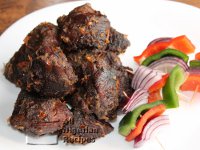Gbegiri soup is a Yoruba (Western Nigerian) soup prepared with beans. On its own, it looks like baby food but it comes alive when you add Ewedu Soup and meat from your Beef & Chicken Stew.
Ingredients for Gbegiri Soup
- 150g Black Eyed or Brown Beans
- 1 small smoked Mackerel/Titus
- 1 tablespoon ground crayfish
- 1 big stock cube
- 1 cooking spoon palm oil
- Pepper and salt (to taste)
Before you cook Efo Riro
- Ensure you have some Beef & Chicken Stew because the beef for the Gbegiri Soup comes from this stew.
- Remove the beans coat and soak the beans for about 3 hours. This soaking makes the beans soft so that it cooks in less time. This way there will be no need to use potash to cook the beans. If you are using peeled and dried beans, you will need to soak it overnight.
- Prepare other ingredients: pound/blitz the pepper and grind the crayfish.
Cooking Directions
- Put the peeled and soaked beans into a sizeable pot. Pour water to cover the beans and start cooking at medium heat.
- While the beans is cooking, prepare the Ewedu Soup which is used to eat the Gbegiri Soup.
- Cook the beans till they become so soft that it practically melts when you mash it with your fingers. This takes about 1 hour. You will need to top up the water from time to time but make sure the water is always at the same level as the beans. This ensures that you have just the right amount of water in the soup when the beans is done.
- Mash the very soft beans with a potato masher. You can also blend it with your kitchen blender for a very smooth consistency. I do not like pouring the hot beans into my blender then pouring it back into the pot after blending. And it is not practical to wait for the beans to cool down, blend it and then continue cooking!
- When you are happy with the smoothness of the beans, add the smoked fish, salt, pepper, crayfish, stock cube and palm oil.
- Cover the pot and cook at medium heat for about 5 minutes or till the oil blends with the rest of the ingredients. This is when the oil changes from red to yellow.
- Stir from time to time so it does not burn.
- That's it! The Gbegiri Soup is done.
Dish the soup with Ewedu Soup, get the meat from your Beef & Chicken Stew and eat with Amala or any other Nigerian fufu meal.

















